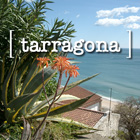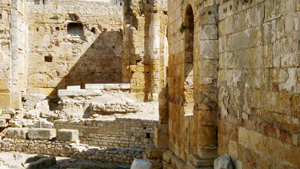
|
Updated 12 March 2006 If you approach the city by train, you might be lucky enough to find a glistening blue sea to your left and the austere keep of the Roman amphitheatre rising on the hill to your right. It's a city with a unique and casual knack for such cohabitation, the ancient inlaid into a thriving modern city. Tarraco was the seat of Roman colonial authority and trade in northeast Hispania, now Catalunya. At the time it first came to prominence, Barcino, seed of thriving metropolitan Barcelona to the north, was but a minor seaside outpost, mainly involving the trade of local crops and resources. It would not grow into a trading or military center until centuries later, when the walls were built and the valley around them began to fill up with merchants looking to trade in the capital. Meanwhile, Tarraco was a colonial capital, a venue for collecting, trading and refining the wares of Hispania. It was the root of a growing local culture and ancestor to the sense of independence characteristic of today's regional culture. While it is unclear what the specific ancient roots of the Catalán language are, it is clear that the Roman colonial culture centered in Tarraco brought about a regional vulgate which differed from the Roman colonies in southern and central Spain. From the station, it is an easy, though uphill stroll past the city's Palau de Congressos and onto the charming, tree-lined Rambla Nova, which leads down to high cliffs overlooking the sea. As with other Catalán cities, this major mixed auto and pedestrian thoroughfare affords the visitor a view of the hills skirting the coastal city to the north and west. From the overlook at the end of the Rambla Nova, a short and enticing walk downhill, across one road and up the coast, takes you to the ruins of the Roman amphitheatre, which includes the base and some of the nave of an early gothic cathedral, right in the center of the arenas. The amphitheatre was the most recent of Tarraco's "entertainment" venues and was built extramuros or outside the walls, on the shore. There is a small monument along the walk from the entrance to the enclosure down to the high arch that leads onto the arenas, which reads "Many innocent lives were taken in this amphitheatre. The city of Tarragona honors 50 years of the Universal Declaration of Human Rights. 1998" The city thoughtfully engages in this representation of past within present, a motif that may seem to be repeated in a number of subtle ways, if one is looking. The old city is a UNESCO World Heritage Site, though one of the less famous, so it has the effect of glazing the city in an historic charm, without the teeming masses of tourists so common at other such sites.
For more travel listings, original narratives and destinations, consult Sentido's sister site for travel, CavaTravel.com... |
||||||||||||||||
|
|||||||||||||||||




